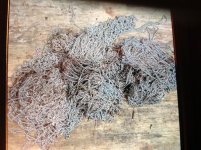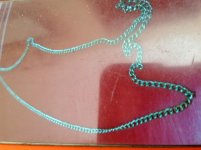Recently found these while clearing land w tractor. Due to size of trees that was being removed I feel safe to say these have been underground for more than 40yrs. They appeared to have been stored in a old tin cake box, the way in was pretty much rusted away. Approximately 300 or more of these necklaces, in bundles of 10-20 secured together with bread ties. Took one to local jeweler, tested....not gold or silver.
They wont respond to a magnet or if they do it's not enough metallic response to even pick one necklace up. That's using a strong magnet.
The necklaces don't have a clasp on them, approx 20" long
There was a few necklaces that did have a jewelry clasp but each one of those necklaces a rusted, responds to magnet and are of no value.
These necklaces have been underground unprotected and came out shining.
I'm lost as to what type of metal these are and more so the use for so many without clasp. Any help with ways to identify this metal will be appreciated.
They wont respond to a magnet or if they do it's not enough metallic response to even pick one necklace up. That's using a strong magnet.
The necklaces don't have a clasp on them, approx 20" long
There was a few necklaces that did have a jewelry clasp but each one of those necklaces a rusted, responds to magnet and are of no value.
These necklaces have been underground unprotected and came out shining.
I'm lost as to what type of metal these are and more so the use for so many without clasp. Any help with ways to identify this metal will be appreciated.






